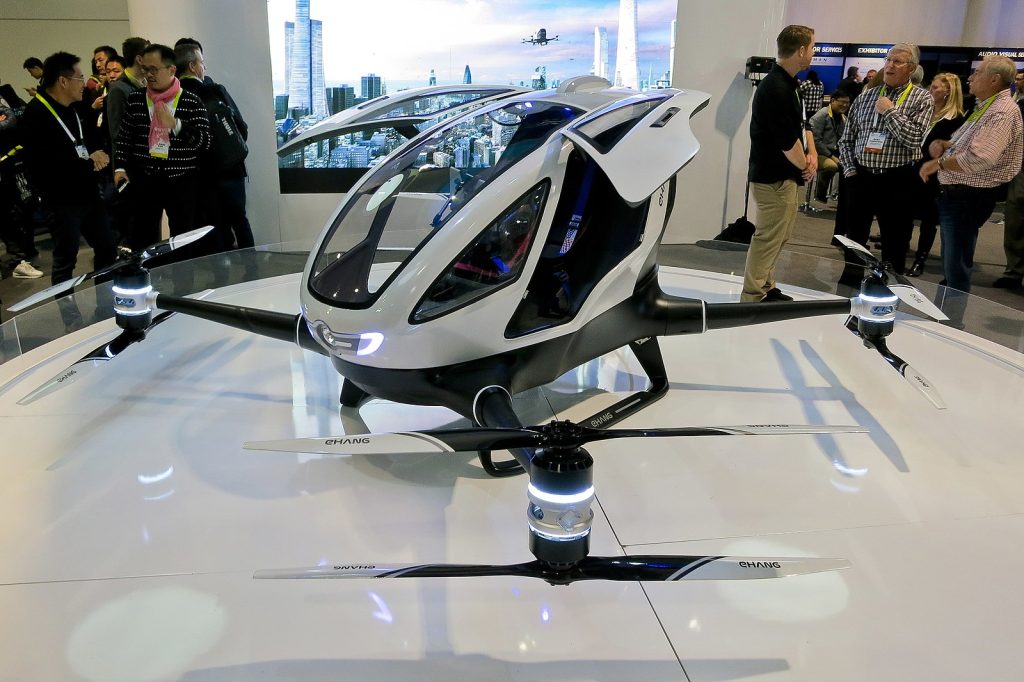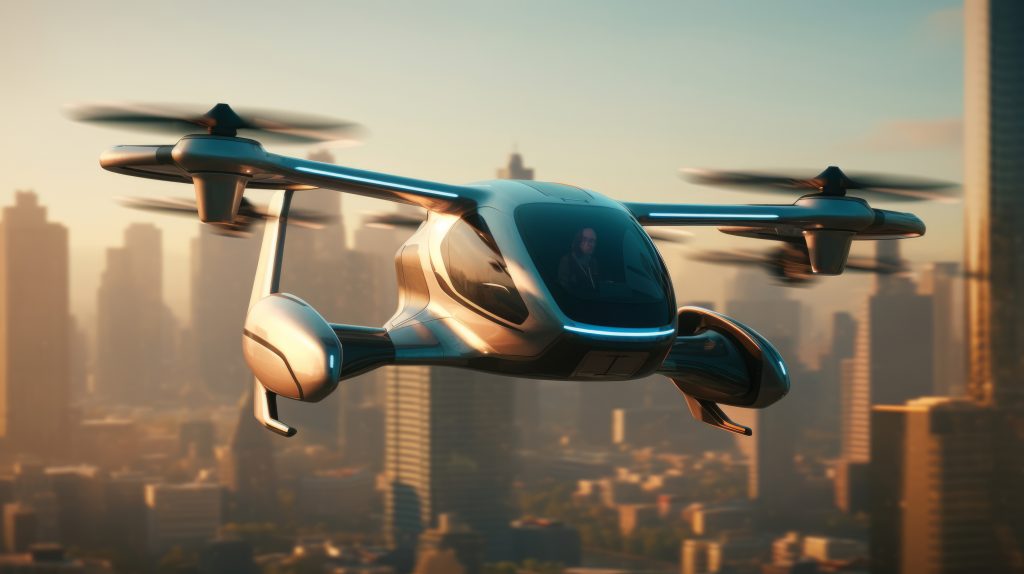The year 2024 has been dubbed the “Year of the Low-Altitude Economy,” with projections that by 2030, it will have grown into a trillion-yuan industry. As a new and emerging industry representing a new frontier in productive forces, the low-altitude economy’s future blueprint is gradually unfolding before our eyes. Imagine a world where hailing a flying vehicle is as convenient as calling a taxi, offering new dimensions to urban mobility. This vision is about to take flight and become a reality.

EHang eVTOL demonstration. Alex Butterfield credit.
According to the “China Low-Altitude Economy Development Report (2024)” released by the China Center for Information Industry Development (CCID) in April, China’s low-altitude economy reached 505.95 billion yuan in 2023, with a staggering growth rate of 33.8%. By 2026, this sector is expected to surpass one trillion yuan, reaching 1.06446 trillion yuan, ushering in a trillion-yuan market. In this heated race, several companies have already emerged as frontrunners, with EHang (Shanghai) Co., Ltd. (hereafter referred to as EHang) leading the charge.
Starting from a rented apartment in Shanghai, over the course of eight years, one autonomous unmanned aerial vehicle after another has taken flight from EHang’s facilities. In 2023, their self-developed electric vertical take-off and landing (eVTOL) aircraft, the M1, successfully completed its maiden flight. Shanghai officials have declared EHang as China’s most formidable competitor in the new global race for low-altitude aviation.
On May 6th, EHang’s Vice President, Yue Tingting said that the company currently has multiple bases for research, development, manufacturing, and test flights in Shanghai and the Greater Bay Area, forming a comprehensive product line ranging from 25kg to 100kg to 2-ton pure electric and hybrid unmanned aerial vehicles. EHang is steadily progressing towards achieving self-reliance and control over eVTOL technology in China.

Hong Kong (GBA) at Night.

Shanghai at Night.
Years ago, they had already set their sights on “urban air mobility.” In late 2023, EHang delivered a keynote speech titled “The Dream of a Domestically Produced New Energy Aircraft in the Low-Altitude Economy,” depicting a scenario that could become reality eight years from now: A city’s transportation system would comprise underground, ground, and air components, with aircraft efficiently crisscrossing between cities in an orderly fashion. Different modes of transportation would complement each other seamlessly. Office building rooftops could be transformed into take-off and landing pads, while open fields and current heliports could also serve as launch sites. Within this intelligent, multi-dimensional transportation network, most vehicles would run on renewable energy, making them environmentally friendly.

Helipad on buildings.
The key to establishing urban air mobility and ensuring the safe and orderly operation of aircraft lies in possessing self-developed eVTOL technology. eVTOL, an abbreviation for “Electric Vertical Take-off and Landing,” refers to electric vertical take-off and landing aircraft, widely regarded as the primary mode of future urban air transportation. Vertical take-off and landing mean that aircraft can take off and land vertically wherever they can be parked, while “electric” signifies clean energy propulsion. Compared to traditional fixed-wing general aviation aircraft and helicopters, eVTOL aircraft offer advantages such as not requiring runways, a high degree of intelligence, a lower pilot skill threshold, and lower operating costs.
As early as 2015, EHang’s founders began contemplating how to find the eVTOL configuration with the smallest performance trade-offs. Driven by their passion for aviation, the two left their jobs at Commercial Aircraft Corporation of China Ltd. (COMAC) and established Fcourier Aviation, the predecessor of EHang, in a 1,500 yuan per month rented apartment in Shanghai’s Pudong district.
In 2019, after nearly 5 years of continuous investment and optimization, Fcourier Aviation unveiled the E6 fixed-wing unmanned aerial vehicle with a “retractable rotor” vertical take-off and landing technology, achieving reliability for tens of thousands of take-offs and landings. Simultaneously, with advantages such as rapid deployment, long endurance, long range, strong wind resistance, stable video transmission, flexible payload, and high safety index, this model gained recognition across multiple industries, including public security, emergency response, firefighting, and border control.
According to EHang’s Vice President, from sketching designs to handcrafting model prototypes, the company that started in a rented apartment gradually attracted a team of core R&D personnel from major aircraft programs. Today, they have a professional and seasoned R&D staff. The team’s various small and medium-sized industrial drones have found widespread application in areas like public safety, infrastructure inspection and maintenance, maritime patrol, and emergency firefighting.
However, industrial drones were not EHang’s ultimate goal. Building on the foundation of Fcourier Aviation, the EHang brand was officially established in April 2021, marking their foray into the eVTOL arena. In May of the same year, EHang completed the maiden flight of a 1/2 scale manned eVTOL verification prototype, validating control algorithms and software/hardware for hover, transition, and cruise modes. Hardware system tests were also conducted at an altitude of 4,700 meters and in low-temperature environments, resolving critical technical challenges.
On the low-altitude aviation track, while EHang sees boundless opportunities, they also face numerous challenges. Disclosed media data shows that the global market for eVTOL aircraft is valued in the trillions of US dollars. By 2050, tens of thousands of eVTOL aircraft will be in operation worldwide, providing services like air taxis, airport shuttles, and intercity flights. Currently, global aviation manufacturers like Airbus, Boeing, and COMAC, as well as automakers like Volkswagen, Toyota, and Xpeng, are all establishing or acquiring subsidiaries to develop eVTOL aircraft.
In October 2023, China’s Ministry of Industry and Information Technology, Ministry of Science and Technology, Ministry of Finance, and Civil Aviation Administration jointly issued the “Green Aviation Manufacturing Industry Development Outline (2023-2035).” The outline states that by 2025, electric vertical take-off and landing aircraft (eVTOL) will achieve pilot operations, and by 2035, new general aviation equipment featuring unmanned, electric, and intelligent technologies will achieve commercial and large-scale applications.
The eVTOL aircraft developers’ race is heating up. In addition to EHang, domestic players like Autoflight, Voloflight, Xpeng Aeroht, and TCab have all unveiled their latest manned aircraft models. Internationally, companies like Joby Aviation, Archer Aviation, and Lillium have completed test flights as well. As the market prospect becomes clearer, more capital and companies are pouring into this emerging segment.

eVTOL Aircraft. Vecteezy Credits.
Looking ahead, urban air mobility may be the next major opportunity after the mobile internet and electric vehicles. But transforming this vision into reality will require continuous investment, iteration, and a pooling of expertise across disciplines like aerodynamics, aviation manufacturing, AI, and operational management. The path remains arduous, but developers firmly believe: The sky will no longer be just for watching – it will become the next commuting channel for humanity.
Leave a Reply